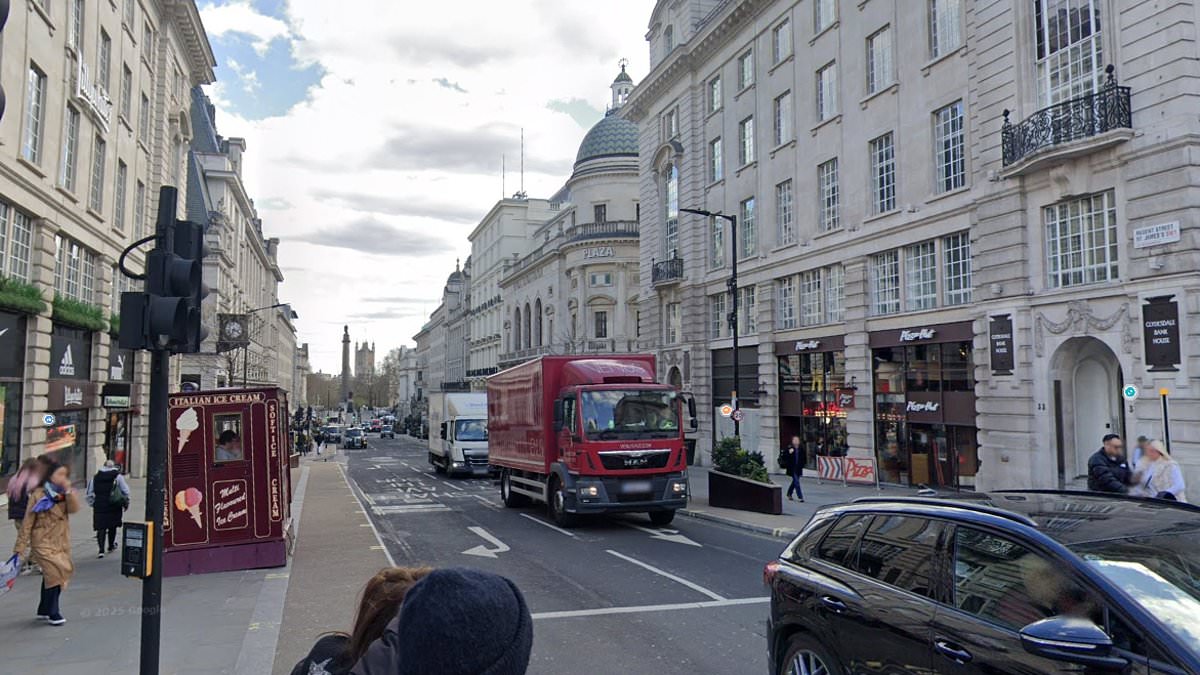By Editor Mark Duell
Another road in London’s West End could be pedestrianised in plans which would also enlarge an existing pedestrian area but risk angering motorists and taxi drivers.
All traffic would be banned from Regent Street Saint James’s, the road which links Piccadilly Circus with St James’s Park, under Westminster City Council’s scheme.
The new plans are separate to the 拢150million proposals already revealed by London Mayor Sir Sadiq Khan last September to pedestrianise key sections of Oxford Street.
But this has faced criticism over fears it could increase crime, raise traffic congestion on surrounding roads and result in more noise and air pollution in quieter areas.
The Mayor confirmed last month that he was pressing ahead with his scheme which would see vehicles banned from a 0.7-mile stretch between Oxford Circus and Marble Arch, with the potential for more changes towards Tottenham Court Road.
In the council’s new scheme revealed today, the existing pedestrian area at Piccadilly Circus would be enlarged while Regent Street would be given new cycle routes.
Two-way traffic would be brought in on nearby Haymarket too under the suggestions revealed this morning in a joint announcement by the council and The Crown Estate.
Regent Street would also undergo ‘greening’ to install more plants, while pedestrian crossings would be improved and the central island on the street taken out.
The council’s draft plan is said to reimagine an ambition set out two centuries ago by famed architect John Nash to connect St James’s Park to Regent’s Park.
Today, City Hall said it welcomed the council’s new plans which ‘complement’ the Mayor’s proposals for Oxford Street, one of the world’s busiest shopping areas.
A spokesperson for Sir Sadiq told MailOnline today: ‘The Mayor’s plans to transform Oxford Street will help to restore this iconic high street and support businesses, London’s hospitality and the nightlife sector, creating new jobs and boosting growth.
‘Given the overwhelmingly positive response to the consultation the Mayor launched this year, Sadiq has brought forward his plans to create a Mayoral Development Corporation (MDC) to super charge regeneration, and detailed plans are being developed for the phased pedestrianisation of the street.
‘The Mayor is committed to re-inventing Oxford Street and the MDC will work alongside government, businesses, local councils and local residents to develop and deliver a bold new vision for London’s flagship high street as we build a better, safer and more prosperous London for all.’
Geoff Barraclough, the council’s cabinet member for planning and economic development, said the plans would create ‘a new network of public spaces’.
He added: ‘This is a rare opportunity to reimagine the heart of the West End as a greener, more welcoming and accessible place that works better for residents, visitors and local businesses alike.
Mr Barraclough encouraged workers, residents and visitors to the area to take part in a public engagement process which will run until August 10.
Kristy Lansdown, managing director for development at The Crown Estate, said: ‘The nature of cities is changing, with new challenges and opportunities emerging every year.
‘Like other global cities, we are collectively seeking opportunities in London to adapt our places and spaces to ensure they are fit for the future.
‘We now have a unique chance to work in partnership with Westminster City Council to revitalise the heart of the West End as a greener, more inclusive and accessible destination, ensuring London remains competitive on the world鈥檚 stage.’
It comes after Sir Sadiq said last month that plans to ban traffic from part of Oxford Street would be implemented ‘as quickly as possible’ because they are supported by ‘the vast majority of Londoners’.
But those plans were previously criticised by Steve McNamara, general secretary of the London Taxi Drivers’ Association, who raised concerns about crime, saying his members had ‘lost all confidence’ in the police’s ability to keep Oxford Street safe.
He told the Telegraph last September: ‘Of course, that’s compounded by the level of street crime that they witness on a daily basis.
‘The big thing that our members witness on a daily basis is phone snatches in London. And so they’re thinking, well, what’s the point in me ringing up and reporting that when nobody’s doing anything about it?’
Meanwhile Julie Redmond from the Marylebone Association group warned pedestrianising Oxford Street would have ‘several negative impacts on residents in the surrounding areas’.
She told of an ‘increase in traffic congestion on nearby residential streets, more noise and air pollution in quieter areas, affecting the quality of life for those living there’.
Restrictions already in place mean between 7am and 7pm vehicular access to parts of Oxford Street is limited to taxis and buses, except on Sundays.
But the redevelopment is set to require 16 bus routes to be removed or diverted – including the 98 and 390 which run the full length of Oxford Street.
Sir Sadiq’s office said last month that two-thirds (66 per cent) of respondents to a consultation support the pedestrianisation plan.
A separate YouGov survey conducted in September 2024 indicated 63 per cent of Londoners are in favour of the project.
Detailed proposals for traffic in the shopping area, which has around half a million visitors each day, will be consulted on later this year.
A previous attempt by Sir Sadiq to pedestrianise that part of Oxford Street was blocked by then-Conservative run Westminster City Council in 2018.
His latest proposals depend on him obtaining permission from Deputy Prime Minister Angela Rayner in her role as Housing Secretary to establish a new Mayoral Development Corporation, which would provide planning powers.
The aim is for this to be created by the start of next year.
